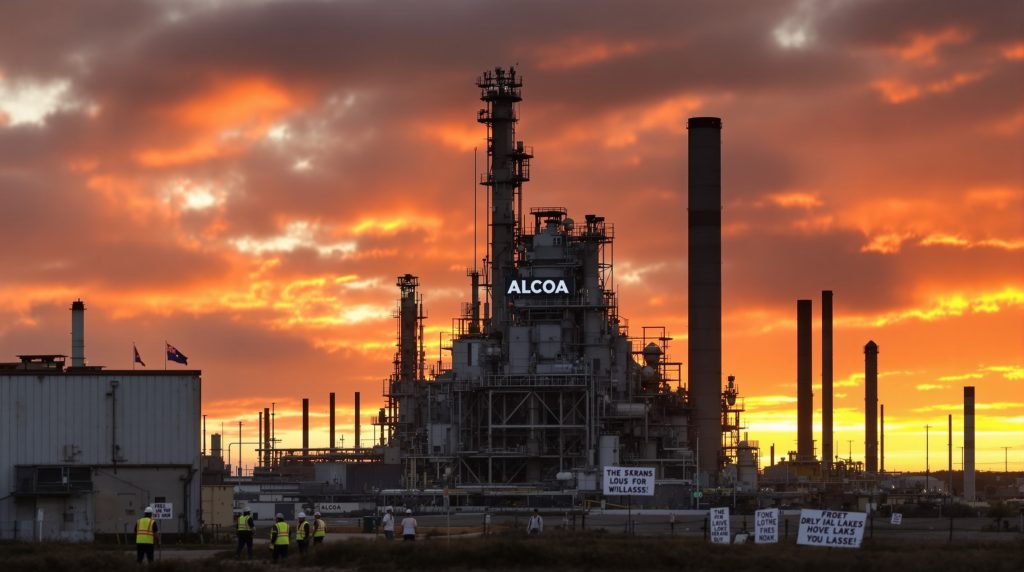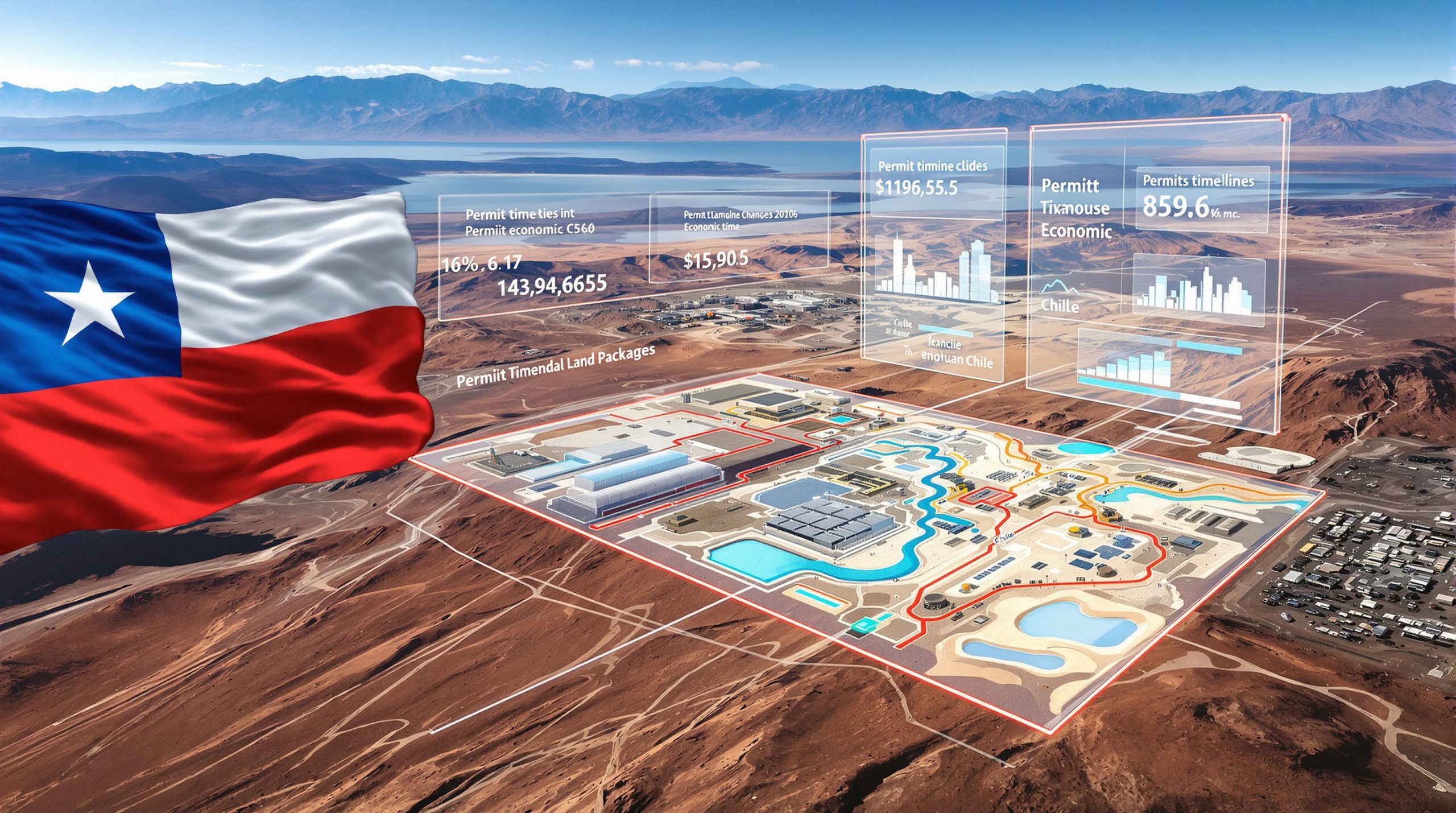Alcoa's Kwinana Refinery Shutdown: Economic Impact and Industry Implications
Western Australia's industrial landscape has experienced a significant blow with aluminum giant Alcoa confirming the permanent closure of its Kwinana alumina refinery. After more than six decades of operation, the 2.2-million-tonne-a-year facility will not restart operations, resulting in the elimination of 220 direct jobs. This pivotal decision follows a period of operational curtailment and unsuccessful attempts to find a sustainable path forward for the aging facility.
The shutdown represents more than just the closure of a production facility; it marks the end of an era for one of Western Australia's most recognizable industrial operations and raises important questions about the future of aluminum production in the region.
Why is Alcoa Shutting Down the Kwinana Refinery?
Age and Infrastructure Challenges
The Kwinana refinery has operated for over 60 years, making it one of Australia's oldest alumina production facilities. This extended operational lifespan has created significant challenges that contributed to the closure decision:
- Aging infrastructure requiring increasingly expensive maintenance
- Outdated production technologies compared to modern facilities
- Higher operational costs due to legacy systems and equipment
- Growing reliability concerns with decades-old components
- Diminishing returns on maintenance investments
The refinery's advanced age placed it at a competitive disadvantage against newer, more technologically advanced facilities both within Australia and globally.
Economic Viability Concerns
Alcoa's decision stems from a combination of economic factors that undermined the refinery's long-term viability:
- Persistently high operating costs relative to newer, more efficient facilities
- Challenging market conditions in the global alumina sector
- Declining bauxite grades from available resources affecting production quality
- Increasing energy costs impacting operational expenses
- Global market price pressures squeezing profit margins
- Strong competition from low-cost producers in other regions
According to company statements, these economic factors created an unsustainable operational environment despite multiple attempts to improve the facility's financial performance.
Failed Revitalization Attempts
Before making the closure decision, Alcoa explored numerous options to create a viable path forward for the Kwinana refinery:
- Comprehensive operational viability studies conducted over several months
- Multiple cost reduction initiatives targeting both fixed and variable expenses
- Operational restructuring attempts to improve efficiency
- Market condition assessments evaluating potential future demand scenarios
- Technological upgrade evaluations to address efficiency gaps
- Supply chain optimization efforts to reduce input costs
Despite these extensive efforts, Alcoa's Executive Vice-President and COO Matt Reed confirmed that the company was unable to identify a sustainable path to restart operations, leading to the difficult but necessary closure decision.
What are the Financial Implications for Alcoa?
Immediate Financial Impact
The closure decision triggers substantial financial consequences for Alcoa:
- $890 million in restructuring charges recorded in the September quarter
- $375 million in non-cash impairments related to facility assets
- Approximately $600 million in cash outlays spread over the next six years
- $75 million in immediate spending expected in the December quarter alone
- Asset retirement obligations requiring significant capital allocation
- Employee-related expenses including severance and benefit payments
These financial impacts represent a substantial short-term cost for Alcoa, though they're considered necessary to address the long-term viability concerns of the company's global operations.
Long-term Financial Considerations
Beyond the immediate expenses, Alcoa faces several ongoing financial obligations:
- Site remediation requirements extending potentially for years
- Environmental compliance costs during and after closure
- Asset retirement expenses for decommissioning specialized equipment
- Employee liability payments including pensions and benefits
- Potential redevelopment expenses depending on future site usage
- Carrying costs for retained infrastructure including port facilities
While substantial, these long-term financial commitments allow Alcoa to responsibly exit operations that had become economically unsustainable while preserving strategically valuable assets like port facilities.
How Will the Closure Affect Western Australia?
Job Losses and Community Impact
The shutdown represents a significant economic blow to the local workforce and broader community:
- 220 direct jobs eliminated at the refinery itself
- Potential for thousands of indirect job losses across the supply chain
- Significant household income reduction throughout the region
- Loss of high-paying industrial positions difficult to replace
- Reduced economic activity in supporting businesses and services
- Community identity impacts in an area historically defined by industrial operations
According to statements from The Nationals WA, the closure could affect up to 5,000 flow-on jobs across the supply chain and wider economy, creating uncertainty for thousands of households in the region.
Political Reactions
The closure has sparked intense political debate in Western Australia:
- The Nationals WA described the shutdown as "a devastating blow to households and the state's economy"
- Claims that approximately 1,000 direct Alcoa jobs have been lost in recent months
- Accusations that government policies have failed to protect industrial jobs
- Debate over whether "red and green tape" contributed to the closure decision
- Questions about industrial relations policies and their impact on operational costs
- Calls for government intervention to support affected workers and communities
Political opposition has characterized the closure as "a damning legacy for a government that has failed to protect jobs, failed to support the WA resources sector impact, and failed to provide the right policy settings to keep WA internationally competitive."
Industrial Significance
The Kwinana refinery closure represents a pivotal moment for Western Australia's industrial corridor:
- Loss of a major industrial asset with historical significance
- Reduction in the state's alumina production capacity
- Potential ripple effects throughout the industrial supply chain
- Questions about the future of heavy industry in the region
- Concerns about Western Australia's long-term industrial competitiveness
- Shifting balance between traditional industries and emerging sectors
As one of Kwinana's most recognizable employers for generations, the refinery's closure marks not just an economic shift but a cultural transition for an area historically defined by industrial production.
What Happens to the Kwinana Site Now?
Transition Planning
Alcoa has outlined a structured approach to managing the site's future:
- Retention of some workers beyond 2026 specifically for site preparation activities
- Continued operation of strategically valuable port and rail facilities at Kwinana
- Active collaboration with the Western Australia government on future land use planning
- Exploration of potential redevelopment opportunities for the industrial site
- Environmental assessment and remediation planning
- Preservation of infrastructure that could support future industrial activities
This phased approach allows for a responsible transition while preserving valuable logistics assets that remain economically viable.
Ongoing Operations
While the refinery itself is closing, not all Alcoa operations in the region will cease:
- Port and rail infrastructure will remain operational supporting other activities
- Other Western Australian and Victorian assets will continue functioning
- Some employees will be retained for site management and transition activities
- Selected maintenance functions will continue to support remaining infrastructure
- Administrative operations supporting other facilities will continue
- Planning and redevelopment teams will maintain a presence
This partial operational continuity highlights Alcoa's ongoing commitment to Australia despite the difficult decision to close the Kwinana refinery specifically.
How Does This Fit Into Broader Industry Trends?
Global Aluminum Industry Pressures
The Kwinana closure reflects wider challenges facing the aluminum industry worldwide:
- Increasing competition from newer, more efficient facilities in emerging markets
- Rising energy costs affecting operational viability globally
- Stringent environmental regulations impacting older facilities disproportionately
- Market volatility creating uncertainty for marginal operations
- Technological advances making older facilities less competitive
- Industry consolidation favoring larger, more efficient operations
These global pressures have forced aluminum producers worldwide to critically evaluate their asset portfolios and prioritize facilities with sustainable competitive advantages.
Australian Resources Sector Challenges
The shutdown occurs against a backdrop of broader concerns about Australia's industrial competitiveness:
- Claims of excessive regulatory burdens increasing compliance costs
- Industrial relations changes potentially impacting labor flexibility and costs
- Energy price concerns affecting energy-intensive manufacturing
- Questions about long-term investment attractiveness compared to other regions
- Infrastructure constraints limiting operational efficiency
- International competitiveness pressures from lower-cost producers
Industry advocates argue these factors create a challenging environment for maintaining Australia's traditional manufacturing base, particularly in energy-intensive sectors like aluminum production.
Future Outlook for Aluminum Production
The closure raises important questions about the future landscape of aluminum production:
- Accelerating trend toward newer, more energy-efficient facilities
- Potential industry consolidation as older plants become uneconomical
- Shift of production to regions with lower operational costs
- Increasing focus on sustainability and environmental performance
- Growing importance of vertical integration to control input costs
- Rising premium for low-carbon aluminum as markets prioritize green transition strategies
These trends suggest the aluminum industry is undergoing a significant transformation that will likely continue to challenge operators of older, less efficient facilities.
What is Alcoa's History and Future in Australia?
Historical Significance
Alcoa has maintained a substantial presence in Australia for decades:
- The Kwinana refinery operated continuously for more than 60 years
- The company has been a major contributor to Western Australia's economic development
- Alcoa's operations have supported thousands of jobs across multiple generations
- The company has been integral to Australia's aluminum industry development
- Significant infrastructure investments have shaped regional development
- Deep community connections through generations of employment
This long-term presence has established Alcoa as a cornerstone of Australia's industrial landscape, particularly in Western Australia.
Continuing Australian Operations
Despite the Kwinana closure, Alcoa maintains other significant assets in Australia:
- Other Western Australian facilities remain operational and productive
- Victorian operations continue to contribute to Australia's aluminum sector
- Port and rail infrastructure at Kwinana will still function to support other activities
- The company remains a significant employer in the Australian resources sector
- Ongoing investments in remaining facilities demonstrate continued commitment
- Strategic importance of Australian operations within Alcoa's global portfolio
This continued presence indicates that while the Kwinana facility specifically was no longer viable, Alcoa remains committed to its broader Australian operations where economic conditions support sustainable production.
What Support is Available for Affected Workers?
Transition Assistance
Workers affected by the closure may have access to various support mechanisms:
- Potential redeployment opportunities within remaining Alcoa operations
- Career transition services and job placement assistance programs
- Skills retraining programs for alternative employment opportunities
- Financial planning and support services during transition
- Early retirement options for eligible employees
- Extended benefits during job search periods
The effectiveness of these programs will be crucial in determining how successfully affected workers can transition to new employment opportunities.
Government Response
The Western Australian government faces pressure to provide comprehensive support:
- Targeted assistance programs specifically for affected Kwinana workers
- Regional economic development initiatives to create alternative employment
- Industry attraction efforts to replace lost industrial jobs
- Coordination with federal programs for displaced workers
- Skills training and certification programs aligned with growth industries
- Economic diversification strategies for affected communities
The scope and effectiveness of these government responses will significantly impact the long-term economic outcomes for affected workers and communities.
Industry Outlook and Environmental Considerations
Sustainability Challenges
The Kwinana closure highlights the sustainability challenges facing older aluminum facilities:
- Increasing pressure to reduce carbon emissions from energy-intensive processes
- Growing cost disparities between older and newer facilities
- Rising standards for environmental performance and remediation
- Technological obsolescence accelerating economic depreciation
- Energy efficiency requirements becoming more stringent
- Market premiums for low-carbon aluminum production
These sustainability factors increasingly influence investment decisions and operational continuity in the aluminum industry globally.
Site Remediation Requirements
Environmental considerations will play a major role in the site's future:
- Comprehensive environmental assessment of soil and groundwater conditions
- Remediation planning for any identified contamination issues
- Regulatory compliance requirements for industrial site closure
- Long-term monitoring obligations extending beyond active operations
- Redevelopment constraints based on historical industrial usage
- Opportunity for environmental improvement through mine reclamation trends
These environmental factors will influence both the timeline and cost structure of the site's transition to potential future uses.
FAQ: Alcoa Kwinana Refinery Closure
When will the Kwinana refinery completely shut down?
The refinery has already been curtailed and will not restart operations. The complete shutdown process will extend over several years, with some workers remaining until 2026 to prepare the site for potential redevelopment. This phased approach allows for responsible decommissioning and transition planning.
Will Alcoa maintain any presence in Kwinana?
Yes, Alcoa will continue to operate its port and rail facilities at Kwinana, though the refinery itself will be permanently closed. These logistics assets remain valuable components of Alcoa's Australian operations and will continue to function supporting other activities.
What happens to the refinery site after closure?
Alcoa has committed to working with the Western Australia government on future land use planning and potential redevelopment opportunities. The site preparation process will extend beyond 2026, with specific redevelopment options dependent on environmental assessment, remediation requirements, and market conditions.
How many jobs will be lost due to the closure?
Directly, 220 jobs will be eliminated at the refinery. However, industry observers suggest the total impact could affect thousands of additional jobs across the supply chain and wider economy, with some estimates placing the number as high as 5,000 flow-on positions at risk.
Is this closure part of a larger trend for Alcoa in Australia?
While Alcoa is closing the Kwinana refinery, the company has confirmed that its other Western Australia and Victorian assets will continue operating. The Kwinana closure appears to be a facility-specific decision based on that particular refinery's economic viability rather than a broader exit strategy from Australian operations.
Aluminum Industry Outlook in Australia
Competitive Positioning
Australia's aluminum industry faces specific competitive challenges:
- Energy cost disadvantages compared to some international producers
- Distance from major markets increasing logistics expenses
- Aging infrastructure requiring significant capital investment
- Environmental compliance costs affecting operational economics
- Labor cost differentials with emerging market producers
- Resource quality variations impacting production efficiency
These factors create a complex competitive landscape that varies significantly by facility age, location, and technological capabilities.
Future Investment Outlook
The future of aluminum production in Australia will depend on several factors:
- Energy policy developments affecting power costs for energy-intensive industries
- Environmental regulatory framework evolution
- Labor market dynamics and industrial relations policies
- Infrastructure investment supporting operational efficiency
- Technological innovation adoption rates in remaining facilities
- Global market demand trends for aluminum products
These variables will determine whether Australia can maintain its position as a significant aluminum producer or will face further facility closures and industry evolution trends.
Conclusion: Broader Implications of the Kwinana Closure
The permanent shutdown of Alcoa's Kwinana refinery represents more than just the loss of a single industrial facility. It signals important shifts in Australia's industrial landscape, global aluminum production trends, and the challenges facing traditional manufacturing in an increasingly competitive global environment.
For Western Australia specifically, the closure creates immediate economic challenges while also opening possibilities for site redevelopment and economic evolution. The response from government, industry, and affected communities will determine whether this transition ultimately leads to economic renewal or prolonged difficulty.
For the global aluminum industry, the Kwinana closure reinforces the ongoing shift toward newer, more efficient facilities and the increasing importance of sustainability factors in operational decision-making. As older facilities worldwide face similar economic pressures, the industry landscape will likely continue to evolve with significant implications for traditional aluminum-producing regions and potential decarbonisation benefits.
Looking for the Next Major ASX Mineral Discovery?
Discover significant mineral discoveries as they happen with Discovery Alert's proprietary Discovery IQ model, which scans daily ASX announcements to provide instant, actionable insights for investors. Explore why historical discoveries like De Grey Mining and WA1 Resources generated substantial returns by visiting Discovery Alert's dedicated discoveries page and begin your 30-day free trial today.




